The osteoarthritis of the knee joint combines two processes: the destruction of the cartilage and the growth of osteophytes or bone spurs.The stage of the process is determined by the radiography.It is believed that osteoarthritis is the destruction of knee joints with age, the natural process of aging.The causes are muscle weakening and the poor blood supply to the fabric.How to be treated without surgery?Eliminate the factors that reduced muscle tone.
Causes
The causes of osteoarthritis are not yet determined by medicine,Only risk factors are named:Age of more than 45 years, knee injuries and overweight.Almost 50% of the adult population has complained about the knee joint.
With osteoarthritis, the cartilage that covers the bones edges is abrasion or completely absent.Damaged tissue is not a source of pain, because it has no recipients.Inflammation in nearby structures causes characteristic symptoms.
The body continues the regeneration of damaged tissues, but the cartilage grows unequally.As a result, irregularities that damage other elements of the articulation are formed.The nature of the osteophytes is explained by compensation for the cartilage of smooth joints.Another version indicates that the growth of "spurs"It is associated with an attempt to stabilize medial or lateral joint due to muscle weakening.
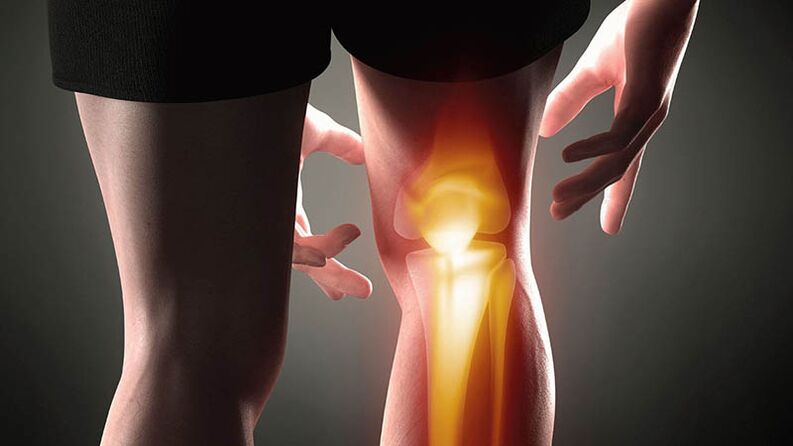
What is the chronic osteoarthritis of the knee joint?Pain occurs in tendons and ligaments only when muscle forces stop sustaining bones and controlling them.Therefore, the biomechanical causes of pain and osteoarthritis are distinguished:
- In the context of a long seatThere is compression between the inguinal ligament and the iliac muscle of the artery and the femoral nerve, which weakens the force of the thigh front and leads to the appearance of tension in the knee cup.
- The long -term session squeezes the gluteal musclesWeakening them.Instead, pear -shaped muscles begin to work, under which the sciatic nerve passes.During its compression, the double head muscle weakens, the thigh angle and the changes in the lower leg change.The knee is injured.
- Walking with heelIt causes voltage of the calf muscles, display the pelvis, weakens the average gluteal muscles.The femoral bone rotates inside, the ligaments are loaded along the interior of the knee, a medial meniscus, osteophytes grow.
- Flat feetAssociated with the use of uncomfortable shoes, the weakening of the main muscles and the increase in lordosis, displays the tibial bone outwards, which leads to knee pain due to the violation of biomechanics, the development of a baker's cyst.
The pathological chains that affect the knee are associated with a fall in the childhood fuck, scoliosis caused by diseases of the internal organs.People who have a different shoulder height,Over time, they begin to complain in the knee, since the fascial chains at the front of the body include the extensor of this joint: the straight muscle of the thigh.
Symptoms
The degenerative process interrupts the function of the joint, leads to pain and rigidity.It is believed to beOf cartilage and bone, the effect on the muscles begins.Practice shows otherwise -Knee joint pain occurs in tendons places- The fasteners of the weakened muscles of extensors, flexors and knee stabilizers.
The main signs of the cartilage wear threat:
- From time to time, the discomfort associated with the walk, the feeling of "did not put on the leg."
- The appearance of pain with a direct load in the joint and muscles, bending it and extending it: underline, climb the stairs.
- Knee pain and rigidity after inaction or prolonged rest, for example, when leaving the bed in the morning, which is associated with the stagnation of venous blood.
The main signs of osteoarthritis are caused by loading in the weakened muscles:
- The knees on the knees are related to the fact that the gluteal and double head muscle that extends the thigh does not work, and the straight muscle of the thigh is excessively stretched, creating discomfort in the knee.
- The pain by bending the joint is associated with the weakness of the flexors: the double head muscle and the quadriceps tendon tension.
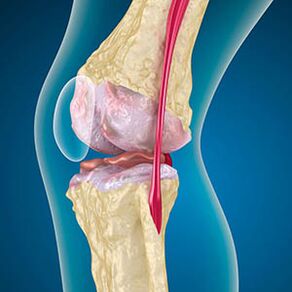
Swelling is caused by a soft tissue injury, inflammation of the tendons and the joint bag.The appearance of heat in the knee, swelling indicates the accumulation of inflammatory exudate -Arthrosis is often accompanied by bursitis, synovites, tendonitis.
The knee crunch is painless and traumatic.Tintineo and other sounds do not say bones are abrasion.Signs of knee stability rape -The weakness of one of the control of the muscles.
The credation caused by the friction of the bone in the bone does not occur at the beginning and end of the amplitude of the movement, but in the middle,Even with passive joint flexion.The joint lock is caused by cartilage wear and tendons, which creates a feeling of fixation.The bones with any movement are controlled by the muscles.Its inoportuna reduction leads to a changed direction of the bone movement, blocking.
1 grade
The determination of the degree of osteoarthritis occurs by X -raysrevealing participation in the pathological process of bone structures.Its change indicates that the muscle system has been in an imbalance for 5-10 years.As a rule, peopleDolores Dolores experience for several years.
In the first stage of osteoarthritis, which is detected by accident, there is a slight increase in bone spurs.Growth appear in places of the highest articulation instability.In general, patients rarely experience pain or discomfort during movement.
The weakness of some muscles is compensated by the function of others, without causing severe spasms and overloads.The race and weight training cause symptoms, since the weakened muscles are loaded.The weakness (hypotension) of the muscles is associated with a deteriorated blood and innervation supply.
2 degrees
The second stage of osteoarthritis is considered easy.The radiography reveals significant bone spuries, but the cartilage is not affected.The amount of synovial fluid is reduced, but the symptoms of pain appear after a long walk and race, stiffness in the joint and pain when folding and in the knees position.
Initial characteristics of X -Ray of the second stage of the osteoarthritis of the knee:
- the pointed edges of the interceptive tubers in the tibia, where the ligament is joined in the form of a cross;
- narrowing of the articular gap on the medial side;
- The pointed edges of the condiles of the bones on the medial sides, less frequently on the side, depending on the development of the valgo or the deformation of the diverse joint.
For the second stage in LarsenThe narrowing of the articular gap in more than 50% is characteristic, but this can only be verified in dynamics or comparison with a different joint.
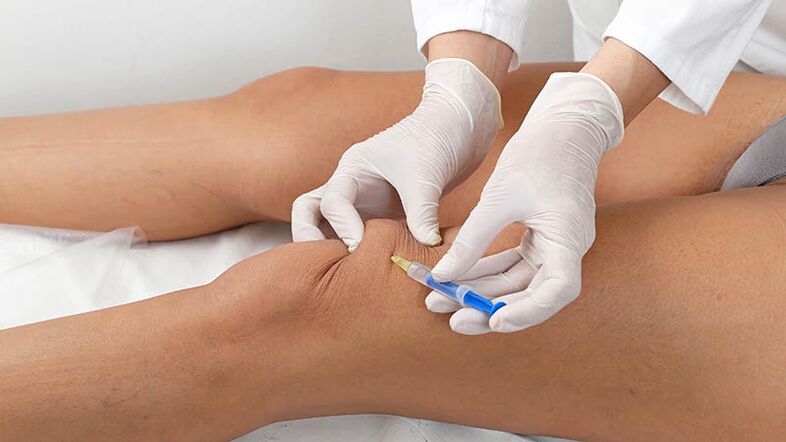
3 degrees
In the third stage of osteoarthritisPain during flexion and joint extension become constant.During the exacerbation, the articulation blushes and swells, sore pains do not stop at rest.Around the knee, the swelling appears, a notable deformation of the joint joints.
Moderate osteoarthritis signs of the knee joint in the third stage:
- The joint gap is significantly reduced;
- the presence of subcondral sclerosis in the loaded sections;
- numerous osteophytes at the edges;
- a rare appearance of subcondral cysts;
- Synovites, the appearance of a baker's cyst under the knee;
- unequal surfaces of femoral and warm, loss of joint joints;
- change in the form of the kneecap;
- Calcification and Condomous Fochers;
Rarely the fourth stage is complemented with necrotic lesions.Why is arthrosis dangerous?The disease violates the ability to move, creates dependence on others.
Diagnosis
The orthopedist studies signs of edema, palpates the articulation for pain, studies the range of active and passive movement.Necessarily inspects the lumbar column, becauseIt is there where the nerves pass, which provide the function of the muscles of the thigh.
Radiography shows the presence of osteophytes, a change in space between femoral and warm bones, indicating the loss of cartilage in the knee.Sometimes, the x line of the knee joints shows significant cartilage wear signs, but patients do not experience significant pain.On the contrary, the osteoarthritis of the first stage can interrupt the knee function, since the cause of pain is hypotonic muscles.
If an x -ray does not show great changes, thenThe doctor prescribes a magnetic resonance of the knee joint and lumbar.The diagnosis visualizes ligaments, tendons and muscles, meniscus to find other sources of pain.
Laboratory diagnosis is necessaryIf you suspect infectious damage to the joint or drop.
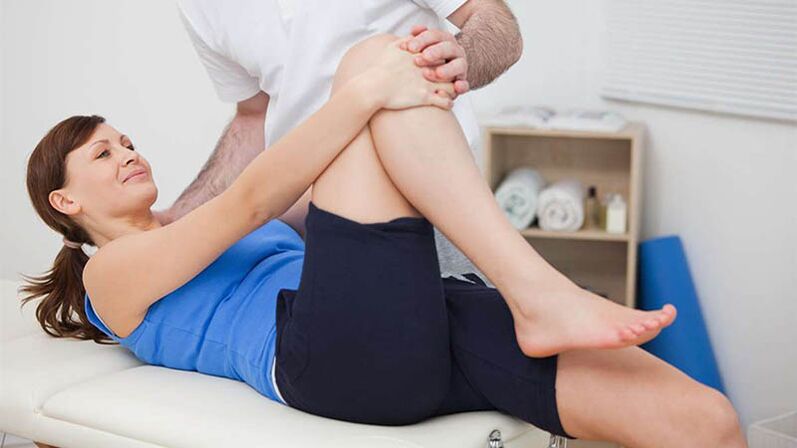
Treatment
Arthosis therapy must be integralaimed at the cause of the disease.With endocrine dysfunctions capable of affecting connective tissues, appropriate treatment is carried out.Overweight patients are recommendedgo to adequate nutrition.Exacerbations are eliminated with medications.
Drug treatment
The pharmacological treatment of pain consists ofPrescription of anti -inflammatory drugs.Non -steroidal anti -inflammatory drugs with prolonged useNegatively affect the stomach function.
The treatment regime includes condoprotectors, which help only when they take long courses during3-6 months.Pharmacies represent a large number of medications in this group.
It is believed that the components of these medications help to regenerate the cartilage structure, have an analgesic effect.
Controlled studies have been conducted by Little, and referred to complex treatment: arthroplasty, physiotherapy, diet.
Attention!Condroprotectors are drunk in the courses (you can drink a course of a drug and the second year, the other, and compare the effect. However, the un controlled medication is not the best idea. Before starting to take medications, consult your doctor who attended it.
How and what to relieve pain and swelling?Intra -articular injections are more popular:
- Steroid drugsInhibits inflammatory reactions at immune cell level, eliminating acute pain, joint and swelling joints.
- Hyaluronic acidIncreases the viscosity of the joint fluid, reducing the friction of the articular surfaces.
Important!The effect of drugs is sufficient for 6-12 months, but at the same time degenerative processes do not stop.
Surgical treatment
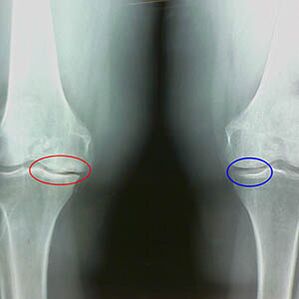
With low effectiveness of medicines, patients are offered arthroscopy- A minimally invasive procedure for the elimination of bone growths, the articulation audit.If necessary, surgeons carry out ligaments and cartilage plastic, remove the spotlights from the worn fabric.
The osteotomy of the bones aims to change the axis of the load in the joint.The doctor cuts the femoral or the berets to change the contact areas of the articular surfaces.The operation is often carried out in young patients.
Total knee joint replacement or arthroplastyIt is required in the severe stage of osteoarthritis (third or fourth grade).Surgical treatment does not always solve the problem, since it requires diligent and daily rehabilitation, muscle strengthening.
Changes in the knee can be compensatory in relation to the pelvis, therefore, without the restoration of muscle balance, the hip joint suffers below.
Physiotherapeutic treatment
In the physiotherapy environment, mud, phonoforesis and magnetic therapy applications are used.The action of external factors is aimed atStimulation of the blood supply and tissue regeneration, relief of inflammation and swelling.
Treatment with popular and non -traditional methods
Popular remedies recipes for the treatment of osteoarthritis of knee joints at homeaimed at eliminating swelling and eliminating pain.Most of the time, spicy radish leaves and potato sweets are used, sometimes they are mixed and vodka for compresses.
It is impossible to completely stop degeneration.It can affect the exchange in the kidneys with celery juice.The kidneys are associated with the luxury iliac muscle, which is associated with hip joint pathologies.The normalization of the function of the gallbladder and the liver improves the condition of the knees.
The methods to treat the initial stage of the initial stage of knee osteoarthritis include decoctions of anti -inflammatory herbal:Mannomile, San Juan grass, immortality.Ground garbage, sea salt and kerosene are used.Bathrooms are used with magnesium salts, pine infusions.
Manual therapy and massage
Manual therapy for osteoarthrosis of the knee joint helps, if a specialist understands the only mususcular imbalances.Muscle tests help to find weakened muscles that stabilize the knee, determine the cause of dysfunction and eliminate it.
The source can be not only the articulation block in the lumbar region,But also dysfunctions at the level of blood supply, internal organs, endocrine and biochemical failures.Therefore, the manual therapist must have osteopathy skills, applied kinesiology to influence many factors.
Massage is an auxiliary tool for manual therapy, Selfhelp.A patient with osteoarthritis of the knee joint can independently knead the tendons of the muscles that control the movement of the limb:
- the area around the large gluteus muscle;
- lines on the front surface of the thigh, from the pelvis to the kneecap;
- The lateral surface of the thigh from the great swing to the thigh condyles;
- The groin area along the inguinal ligament;
- The internal surface of the thigh (along the main channel line).
The massage is done at the point, without much pressure.
Therapeutic gymnastics
The cause of osteoarthritis is the weakening of the muscles caused by problems in the lower back, the basin, the abdominal cavity.Perform exercises for the prevention of arthritis and osteoarthritis of the knee joints for the elderlyIt is possible to increase force, but not the tone.
Without working on the factors of its weakening with the help of manual therapy, it is difficult to achieve a complete restoration of biomechanics.Yoga even more deprives stability joints.Among the treatment methods, it is better to preferPilates and Scandinavian walk.
Diet
The food fits, first of all, to fight overweight.It is important to leave sugar and simple carbohydrates., add products with fiber, magnesium, vitamins of group B and calcium with osteoarthritis of the knee joint, which are important for muscle activity.AttemptExclude dairy products, since almost 80% of the population has lactose intolerance.
Prevention of osteoarthritis of the knee joints
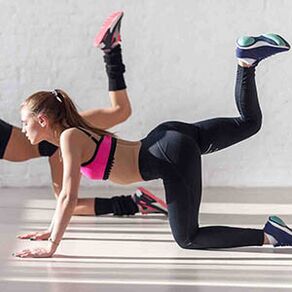
Attempts to strengthen muscles do not always help, since innervation and blood supply are not restored.The function of the hip muscles depends on the lumbar plexus.
Changes in the lower back associated with the weakness of abdominal muscles also affect the knees.Therefore, in men with a "beer belly", osteoarthritis is more common, as in women after the multiple guide, several genres with diastasis, a weakening of the muscles of the abdominal wall.
The operations in the pelvis and the internal organs form adhesions that affect the vertebrae of the lumbar region, violating the innervation of the muscles around the knee.
What doctor contact the osteoarthritis of the knee joint?The diagnosis will help make an orthopedistwho will insist on the operation.The best results are given by the work of multidisciplinary teams in the rehabilitation centers.
The best thing to do for the joints:Eat on the right, monitor the weight, walk more, visit a massage therapist or an osteopath once every three months.
Treatment reviews
Positive reviews can only provide an integral treatment of deforming osteoarthritis of the knee joint or gonarrosis.Anesthesia, intra -articular injections act temporarily, suppressing a natural inflammatory reaction.
Conclusion
The problem of osteoarthritis is that pharmacological therapy temporarily eliminates only pain syndromes.The reasons are left without identification and influence.Ergotherapists who teach how to live with osteoarthritis from the knee joint can help and how to use a cane correctly.But the service is only available in private clinics that make rehabilitation.























